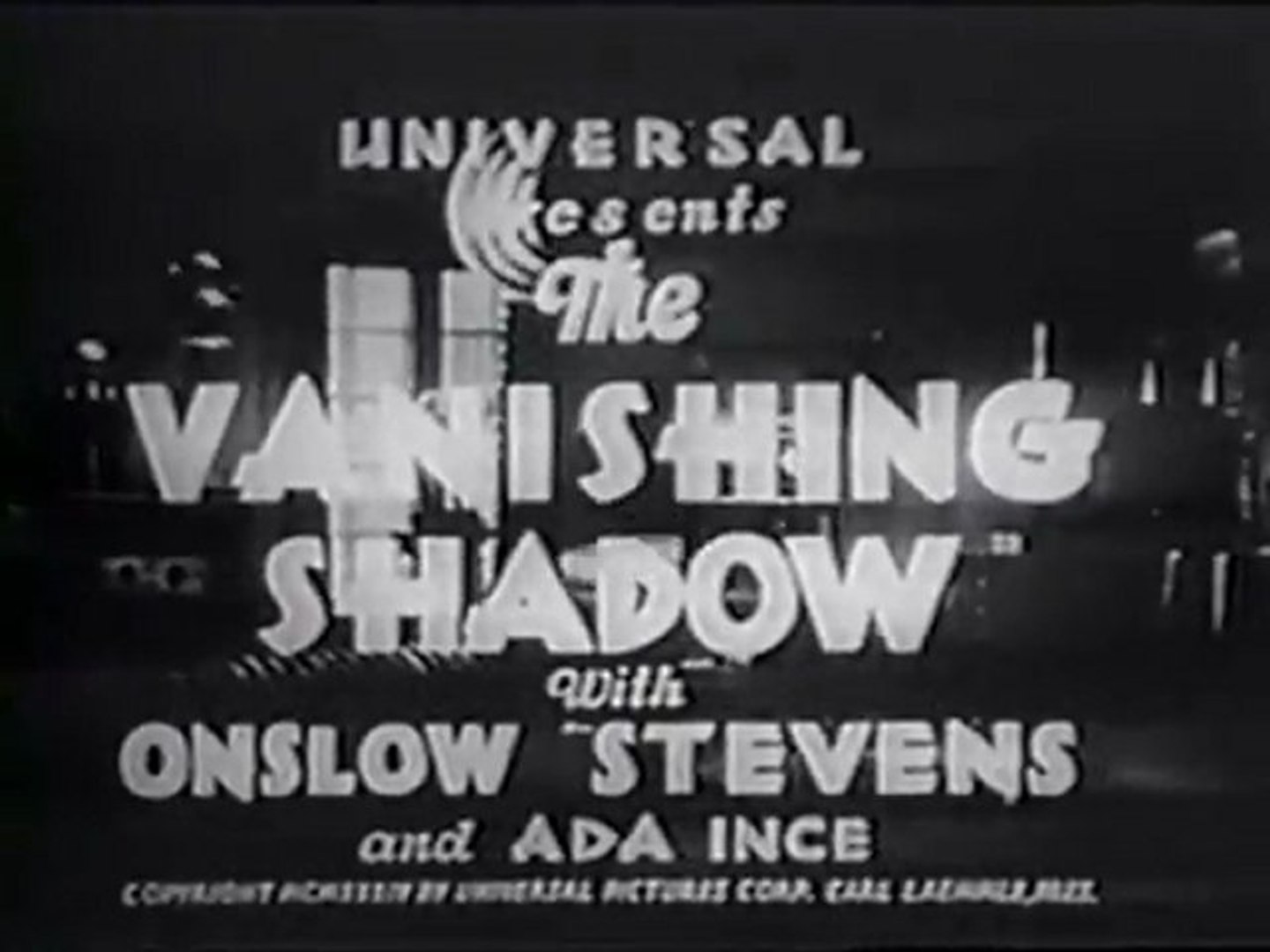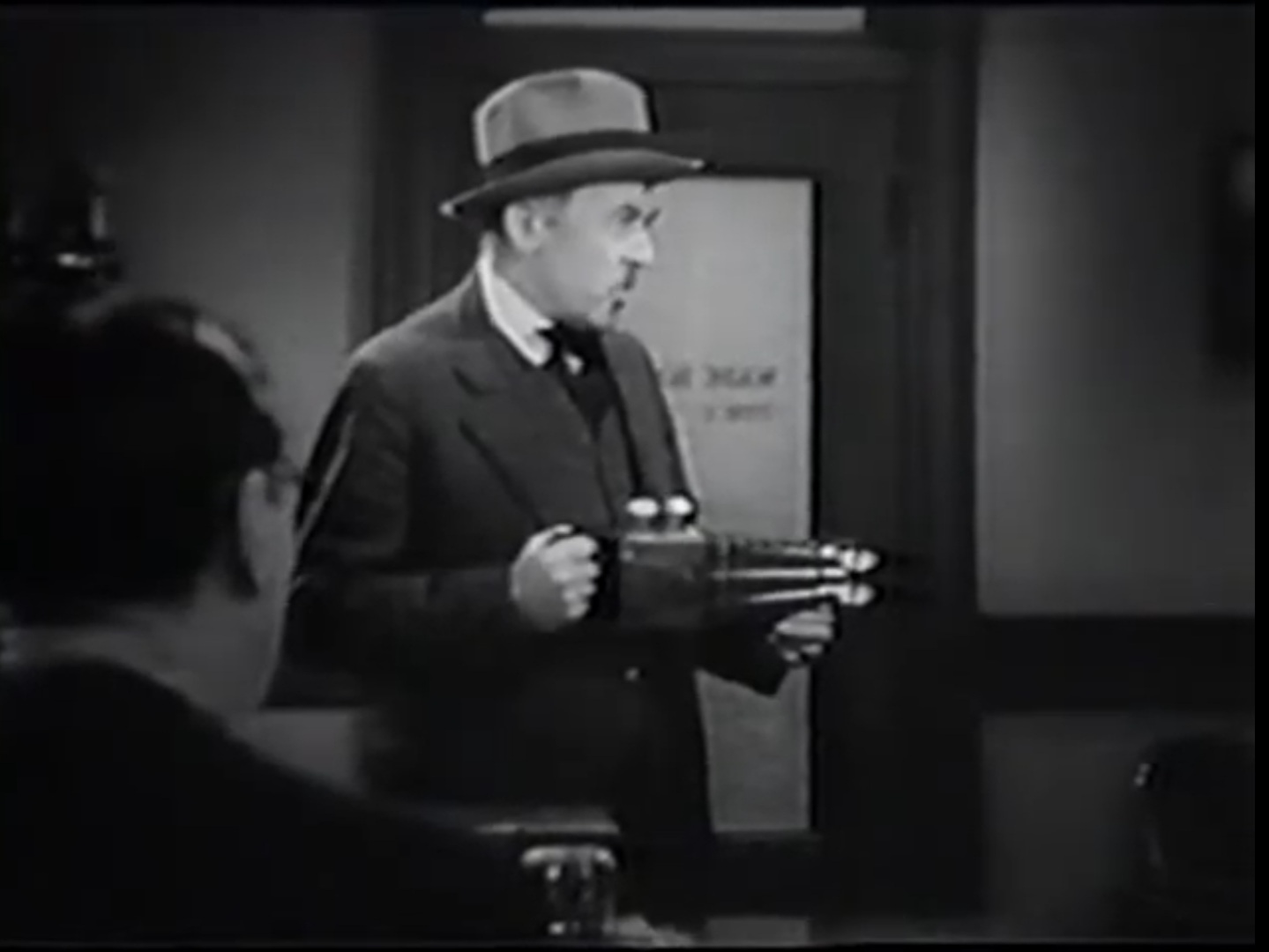
The Vanishing Shadow begins with Stanley Stanfield (Onslow Stevens), heir to the Tribune newspaper and aspiring inventor, visiting the laboratory of Professor Carl Van Dorn to show him plans he has been working on, but which aren’t quite complete. Can the older inventor help him out by troubleshooting the design? Van Dorn is deeply sympathetic to young Stanfield, and tells him he was a supporter of Stanfield’s late father in his crusade against corrupt public figure Wade Barnett. (Although the exact cause is not specified, it is widely believed that the elder Stanfield’s struggles against Barnett led to his death.) Van Dorn accepts the unfinished invention, an invisibility ray, and Stanfield takes his leave. Amazingly, Van Dorn has been working on his own “vanishing ray,” and by examining Stanfield’s plans he is able to solve the problem that had plagued his own design.

Meanwhile, on his way to Barnett’s office, Stanfield saves a young woman, a reporter named Gloria Grant (Ada Ince), from being run over by a speeding fire engine. Gloria is secretly Wade Barnett’s estranged daughter, working at the Tribune under cover to escape her father’s malign influence. When Stanfield gets to Barnett’s office, Barnett (perennial heavy Walter Miller at his oiliest) offers—nay, demands—to buy out Stanfield’s shares of Tribune stock; with that, he would have controlling interest in the paper and be able to quash its coverage of his illegal activities. Stanfield of course refuses, and when Barnett pulls a gun to have his way by force, there’s a struggle in which Barnett’s bond broker, Cadwell, is wounded. Barnett summons help, making it look like a crazed Stanfield just committed murder, and the young man flees.

Back at Van Dorn’s lab, Stanfield pleads for the inventor to hide him. It just so happens that Van Dorn has finished the vanishing ray, and he has Stanfield wear it (it’s a harness-like contraption that goes over the wearer’s chest). It works! The only catch is that anyone using the vanishing ray still casts a shadow (hence the title). Barnett’s main henchman Dorgan (Richard Cramer) and some of his men force their way into Van Dorn’s lab just as Stanfield manages to hide. Of course, they find nothing, but one of them did see a suspicious shadow; it will be several chapters before anyone takes those glimpses as more than just a trick of the light. (The invisibility effects throughout the serial are quite artful, as well as unusually consistent. There are no visible weapons or objects floating around as if being carried by invisible hands; everything the user is wearing or holding becomes invisible with them, except for the telltale shadow they leave behind.)

After this first successful test of the vanishing ray, Stanfield and Van Dorn realize that they have a powerful weapon to use against Barnett, and the game is afoot. The typical serial plot contrivances stretch the story to twelve chapters: Stanfield and Van Dorn strike back at Barnett in a variety of locations; more inventions are produced, including a “destroying ray” and a robot; all three heroes get captured and escape at different times; the Tribune shares, as well as the vanishing and destroying rays, change hands as they are hidden, stolen, and recovered. In the best serial fashion, all of this action throws the character of the players into sharp relief, with heroism and self-sacrifice carrying the day.

One can see elements of the nascent superhero genre coming together: a crusading young man with a father to avenge; a gimmick that gives him an advantage against his enemies, as well as psyching them out; a secret lair in which to tinker on new and improved crimebusting inventions (Van Dorn’s fortified “beach house” turns out to be an even better HQ); and a young woman whose loyalties are divided (while she immediately allies herself with Stanfield’s idealism, Gloria hopes until the end to reform her father rather than destroy him; and Van Dorn suspects her of working against Stanfield on Barnett’s behalf, at least until she proves her good intentions).

Nevertheless, it would be an overstatement to call The Vanishing Shadow “the first cinematic superhero” or somesuch, as the story is firmly rooted in pulp and serial traditions. The uncomplicated wish-fulfillment of Stanfield’s and Van Dorn’s inventions and the melodrama of stock characters reminds me of Pirate Treasure (which immediately preceded The Vanishing Shadow in Universal’s release schedule); the mix of familial drama and science-heroism are also reminiscent of Judex. But Stanley Stanfield would be at home in most any pulp magazine of the era. The fact that he wears a suit rather than a superhero onesie isn’t a dealbreaker, but it does score another point for the “pulp” side. Most notably, the vanishing ray and Van Dorn’s other inventions aren’t set forth as tools for continuing adventures or a general campaign against crime. Defeating Barnett and gaining control of the Tribune aren’t just parts of an origin story: they are the story.

The Vanishing Shadow is “adventure science fiction,” to use Isaac Asimov’s term for that phase of sci-fi in which the gadgets purely serve the thrills and action. The gee-whiz element is turned up as well, appealing to readers of Popular Mechanics and similar DIY magazines: is there anything electrical science cannot do? It’s telling that an “electrical lock” on the Professor’s gates—essentially a remote control garage door opener—is given as much screen time as his robot or destroying ray (the first depiction of a “ray gun” on screen, essentially a spotlight that kills anything the light touches).

Actually, Professor Van Dorn (James Durkin in his final role; he also played Professor Hargrave in the 1933 Perils of Pauline) steals the film. We never learn why the old inventor hates Barnett so much, but if anything he is more bent on revenge than Stanfield. There is almost a good cop/bad cop dynamic between Stanfield and Van Dorn, with the younger man frequently calling off his bloodthirsty partner. In one chapter, Stanfield makes Van Dorn promise not to bring his destroying ray with him on an outing; in the next scene, Van Dorn gets in the car with an obvious rectangular bulge in the front of his jacket. Stanfield tries to moderate Van Dorn, saying things like “I know your way, but we don’t want to murder anybody,” while Van Dorn is given to pronouncements like “The law? You and I will be the law: judge, jury . . . and executioner.” Same planet, different worlds. Frankly, I never got tired of Van Dorn’s obvious relish for wet work; when, after being shown the Professor’s “iron man,” strong enough to break through a brick wall, Stanfield wonders what it would do to a human being, Van Dorn answers without hesitation, “Crush him into mincemeat!” Between the Professor’s propensity to secure his premises with deathtraps and his distrust of Gloria (“There is nothing I fear so much as women!”), it’s a good thing he’s on our side.

Irascible, even mad, scientists are a staple of adventure science fiction, but usually as villains or secondary characters, so the ambiguity of Van Dorn’s heroism is an interesting twist. I was strongly reminded of Bela Lugosi’s turn in The Phantom Creeps from a few years later, and although that serial doesn’t appear to use any leftovers from The Vanishing Shadow, the cranky professor who has both an invisibility device and a killer robot suggests that someone at Universal remembered the earlier production with fondness. Screenwriter Basil Dickey, a well-known name in serials, worked on both films, but that doesn’t mean the similarities were his idea.
The Vanishing Shadow was the first film directed by Louis Friedlander, who would go on to earn hundreds of credits directing serials, B-movies, and (later) television episodes, mostly using the screen name Lew Landers. Like many serials, it has its lulls, but it more than makes up for it in imagination and the quality of its production, and it especially springs to life when Durkin is on screen. The beautiful restoration from VCI makes this an easy one to recommend for fans of serials and retro science fiction alike.

What I Watched: The Vanishing Shadow (Universal, 1934)
Where I Watched It: A Blu-Ray from VCI Entertainment, remastered from long-hidden original 35mm film reels. (The Vanishing Shadow was long-thought lost, but I guess “neglected” might be a better word.) The restoration looks and sounds great, better than many releases of newer films (the screenshots I’ve used here are from YouTube, so they’re not as sharp, but you get the idea).
No. of Chapters: 12

Best Chapter Title: “Hurled from the Sky” (Chapter Five)
Best Cliffhanger: In Chapter Six (“Chain Lightning”), Gloria shows up at her father’s office, with Stanley using the vanishing ray to shadow her invisibly. Suspecting a trap, they head down the back stairs, avoiding Dorgan and his men at the front entrance of the building. Unaware of this and thinking that Stanley has been captured, Professor Van Dorn bursts into Barnett’s office and demands to see Stanley, or else he’ll use his destroying ray on him! Since Stanley had been invisible, Barnett doesn’t know what Van Dorn is talking about, and his fear of being at the mercy of a madman is palpable (and justified). At the same time, Gloria and Stanley have come back to Van Dorn’s lab; Gloria, not knowing that the Professor has set yet another trap, steps onto the pad in front of the safe and is immediately enveloped in bands of lightning. This is such a fun cliffhanger because not only does it cut between two equally suspenseful situations, but the chain of missed connections and misunderstandings that leads to the danger is laid out perfectly for the audience, and once things lock into place it races to the end.

Sample Dialogue: “If that’s the way you treat a friend, Heaven help your enemies!” –Stanfield, after Van Dorn tests out a paralyzing ray on him in Chapter Nine (“Blazing Bulkheads”)
What Others Have Said: “This ‘before-its-time’ gem was no accident. The previous year the studio had a ‘monster’ theatrical hit with director James Whale’s film adaptation of the H. G. Wells novel, The Invisible Man. And so it was imperative to develop more material to capitalize on the success of that film . . . the result was The Vanishing Shadow.” –Ralph Tribbey, DVD & Blu-Ray Release Report (included as liner notes with the VCI release)

What’s Next: Well, after an unexpected two-month hiatus from posting, this is coming out much later than I had planned. With everyone in the family home most of the time, my own personal schedule is completely out of whack. My apologies if new Medleyana posts were the only thing keeping you going (and God help you if that’s the case!). Summer is officially over, but you never know if Fates Worse Than Death will return out of season. It’s happened before!